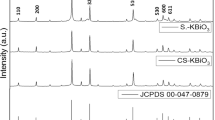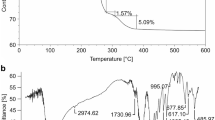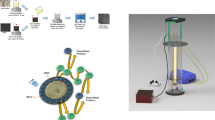Abstract
The present study suggests the approach to select the optimal p-BQ concentration using it as the radical absorber for the catalysts research. It is stated the p-BQ can be subjected to changes during the experiment. It can cause the significant effect on the research results. The impact factors affect the intensity and coloring of the p-BQ. The optimal p-BQ concentration is determined using the photocatalyst based on the alkali earth metal bismuthate during the research.














Similar content being viewed by others
References
A.O. Ibhadon, P. Fitzpatrick, Heterogeneous photocatalysis: recent advances and applications. Catalysts 3, 189–218 (2013)
G. Sahara, O. Ishitani, Efficient photocatalysts for CO2 reduction. Inorg. Chem. 54(11), 5096–5104 (2015)
T. Jafari, E. Moharreri, ASh Amin, R. Miao, W. Song, S.L. Suib, Photocatalytic water splitting—the untamed dream: a review of recent advances. Molecules 21, 900 (2016). doi:10.3390/molecules21070900
D. **g, L. Guo et al., Efficient solar hydrogen production by photocatalytic water splitting: from fundamental study to pilot demonstration. Int. J. Hydrogen Energy 35(13), 7087–7097 (2010)
J. Lia, N. Wu, Semiconductor-based photocatalysts and photoelectrochemical cells for solar fuel generation: a review. Catal. Sci. Technol. 5, 1360–1384 (2015)
Qiong Liu, Yarong Guo, Zhihong Chen, Zhengguo Zhang, **aoming Fang, Constructing a novel ternary Fe(III)/graphene/g-C3N4 composite photocatalyst with enhanced visible-light driven photocatalytic activity via interfacial charge transfer effect. Appl. Catal. B 183, 231–241 (2016)
Feng Niu, Da Chen, Laishun Qin, Tong Gao, Ning Zhang, Sen Wang, Zhi Chen, Jiangying Wang, **ngguo Sun, Yuexiang Huang, Synthesis of Pt/BiFeO3 heterostructured photocatalysts for highly efficient visible-light photocatalytic performances. Sol. Energy Mater. Sol. Cells 143, 386–396 (2015)
Xueyan Li, Renjie Zheng, Qingzhi Luo, Desong Wang, **g An, Rong Yin, Yanyan Liu, Wu Di, **aomin Han, Cyclized polyacrynitrile modified Ag3PO4 photocatalysts with enhanced photocatalytic activity under visible-light irradiation. Appl. Surf. Sci. 356, 941–950 (2015)
Maryam Shekofteh-Gohari, Aziz Habibi-Yangjeh, Ultrasonic-assisted preparation of novel ternary ZnO/AgI/Fe3O4 nanocomposites as magnetically separable visible-light-driven photocatalysts with excellent activity. J. Colloid Interface Sci. 461, 144–153 (2016)
Qingyao Wang, **aotong Wang, Miao Zhang, Guihua Li, Shanmin Gao, Mingyang Li, Yiqing Zhang, Influence of Ag–Au microstructure on the photoelectrocatalytic performance of TiO2 nanotube array photocatalysts. J. Colloid Interface Sci. 463, 308–316 (2016)
Shouqiang Huang, Haoming Wang, Nanwen Zhu, Ziyang Lou, Liang Li, Aidang Shan, Hai** Yuan, Metal recovery based magnetite near-infrared photocatalyst with broadband spectrum utilization property. Appl. Catal. B 181, 456–464 (2016)
Chengyu Yang, Yan Huang, Feng Li, Taohai Li, One-step synthesis of Bi2WO6/TiO2 heterojunctions with enhanced photocatalytic and superhydrophobic property via hydrothermal method. J. Mater. Sci. 51(2), 1032–1042 (2016)
L.F. Fieser, M. Fieser, Advanced Organic Chemistry (Reinhold, Third Printing edition, 1963)
Z.C. Shan, Y.J. **a, Y.X. Yang, H.M. Ding, F.Q. Huang, Preparation and photocatalytic activity of novel efficient photocatalyst Sr2Bi2O5. Mater. Lett. 63, 75–77 (2009)
Y. Wang, Y. He, T. Li et al., Photocatalytic degradation of methylene blue on CaBi6O10/Bi2O3 composite under visible light. Chem. Eng. J. 189–190, 473–481 (2012)
D.S. Shtarev, I.S. Doronin, A.I. Blokh, A.V. Shtareva, Dependency of the optical properties of heterogeneous calcium bismuthate–bismuth oxide particles on the order of layers alternation. Opt. Quantum Electron. 48(7), 1–9 (2016). doi:10.1007/s11082-016-0633-8
R.S. Roth, C.J. Rawn, B.P. Burton, F. Beech, Phase equilibria and crystal chemistry in portions of the system SrO–CaO–Bi2O3–CuO, part II—the system SrO–Bi2O3–CuO. J. Res. Natl. Inst. Stand. Technol. 95(291), 291–335 (1990)
S.H. Yalkowsky, R.M. Dannenfelser, Aquasol Database of Aqueous Solubility. Version 5 (College of Pharmacy, University of Arizona, Tucson, 1992)
A. Musheer, H.K. Zahid, Electronic absorption spectra of benzoquinone and its hydroxy substituents and effect of solvents on their spectra. Spectrochim. Acta Part A Mol. Biomol. Spectrosc. 58(5), 965–981 (2000)
Acknowledgements
We are grateful to the Research Center on Nanophotonics located in the Research Park of Saint-Petersburg State University for the helpful assistance in conducting the diffuse reflectance spectroscopy characterizations and studies of the samples. The research was carried out at the expense of a grant from the Russian Science Foundation (project No. 17-73-00007).
Author information
Authors and Affiliations
Corresponding author
Rights and permissions
About this article
Cite this article
Shtarev, D.S., Shtareva, A.V., Blokh, A.I. et al. On the question of the optimal concentration of benzoquinone when it is used as a radical scavenger. Appl. Phys. A 123, 602 (2017). https://doi.org/10.1007/s00339-017-1193-x
Received:
Accepted:
Published:
DOI: https://doi.org/10.1007/s00339-017-1193-x




